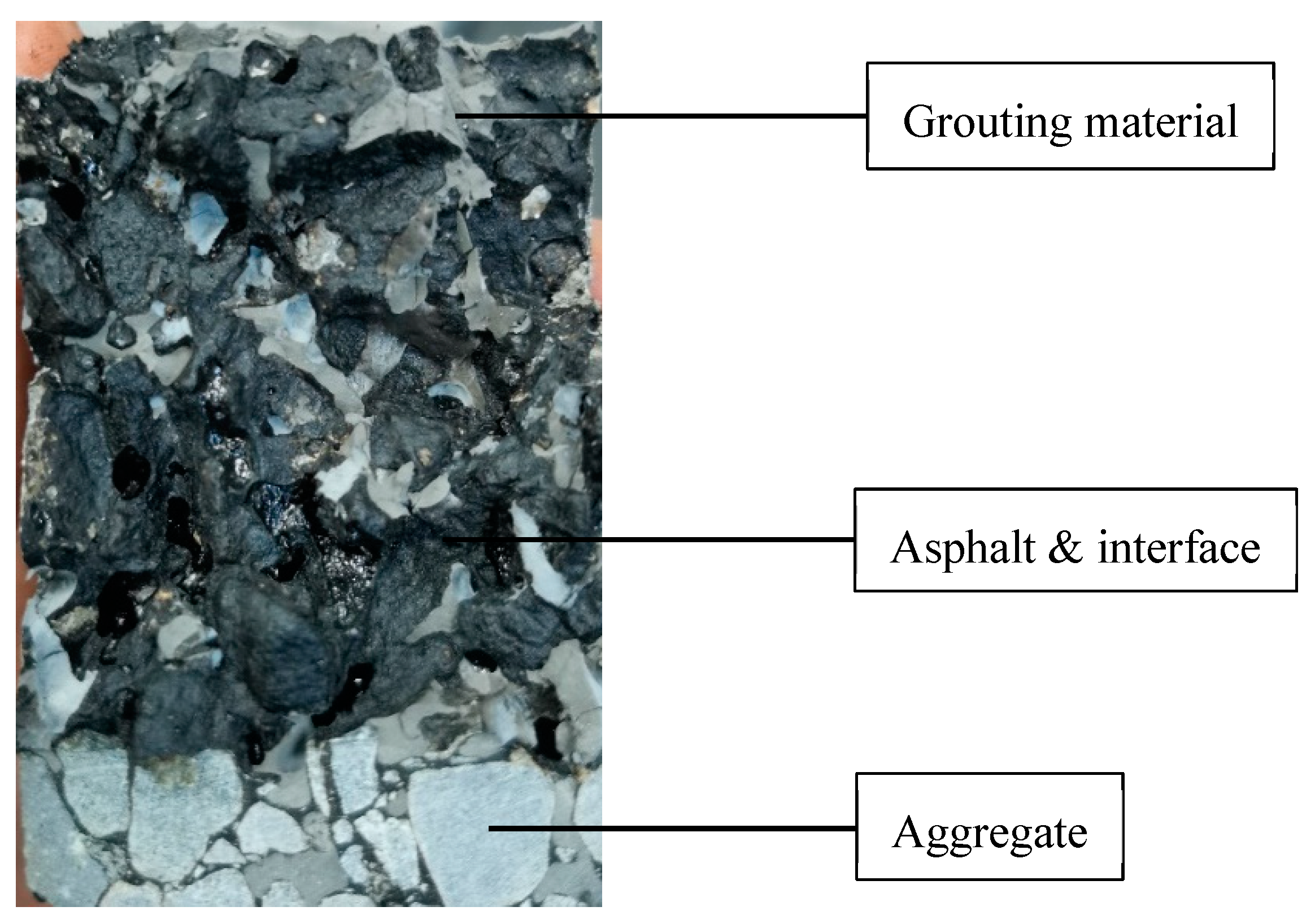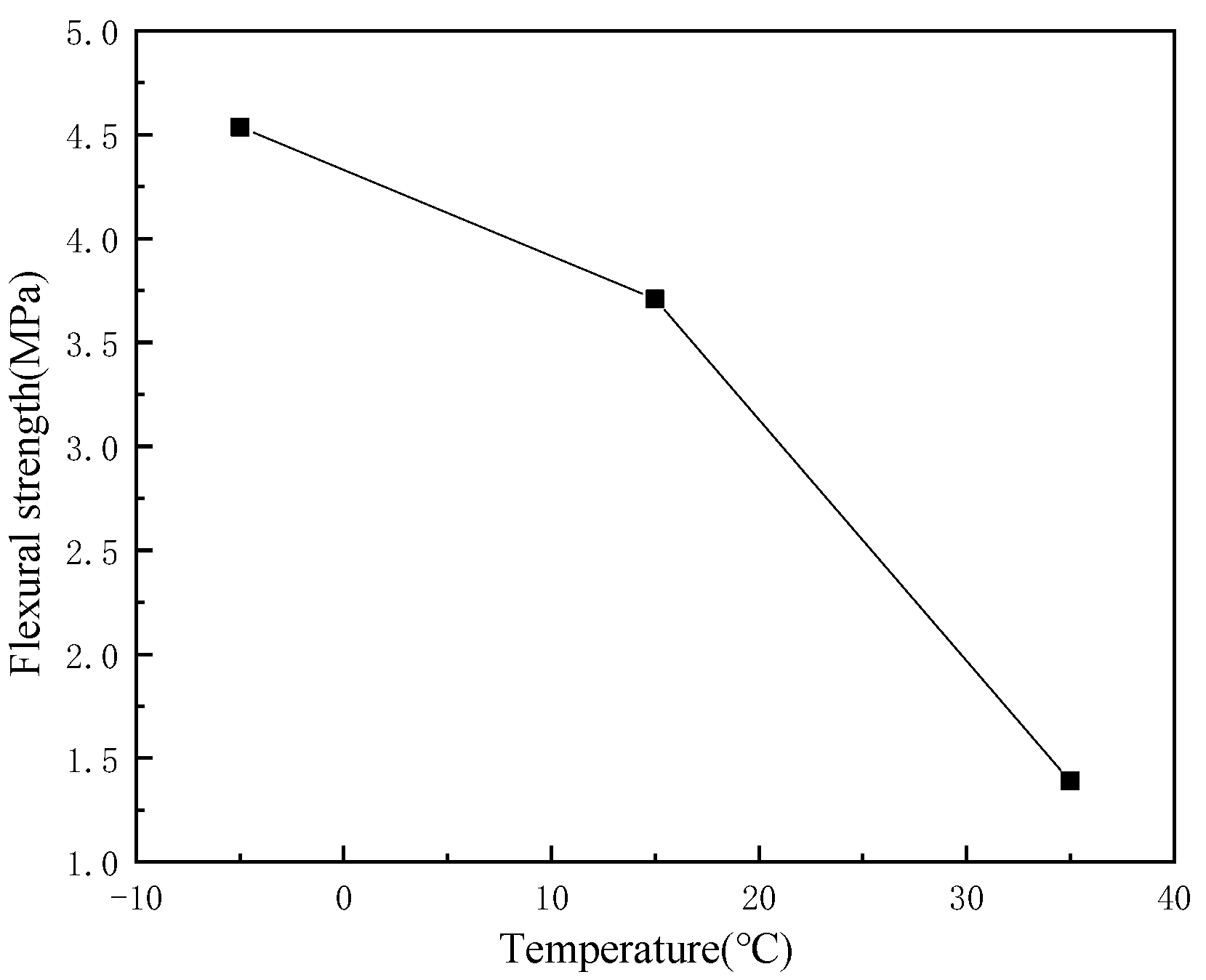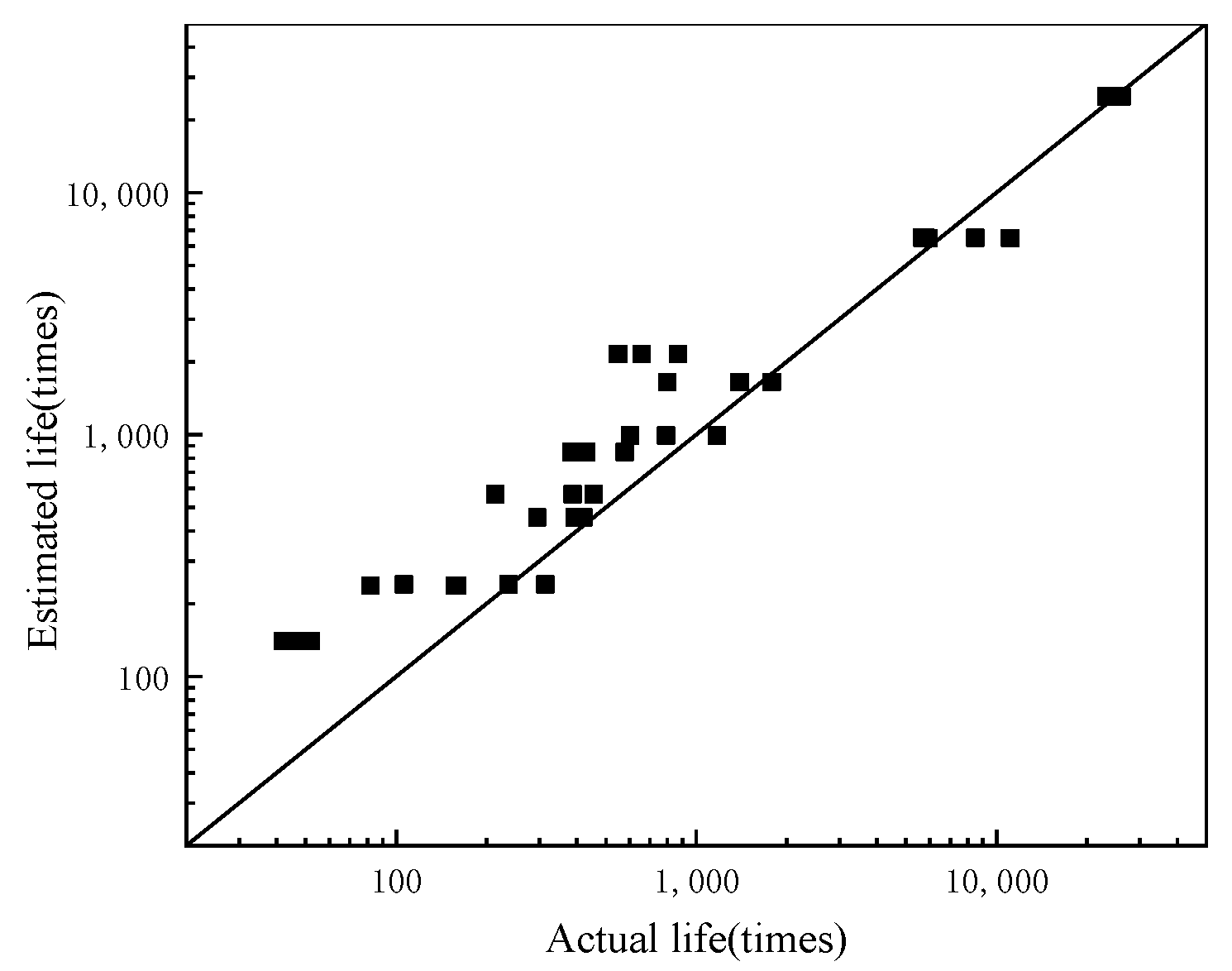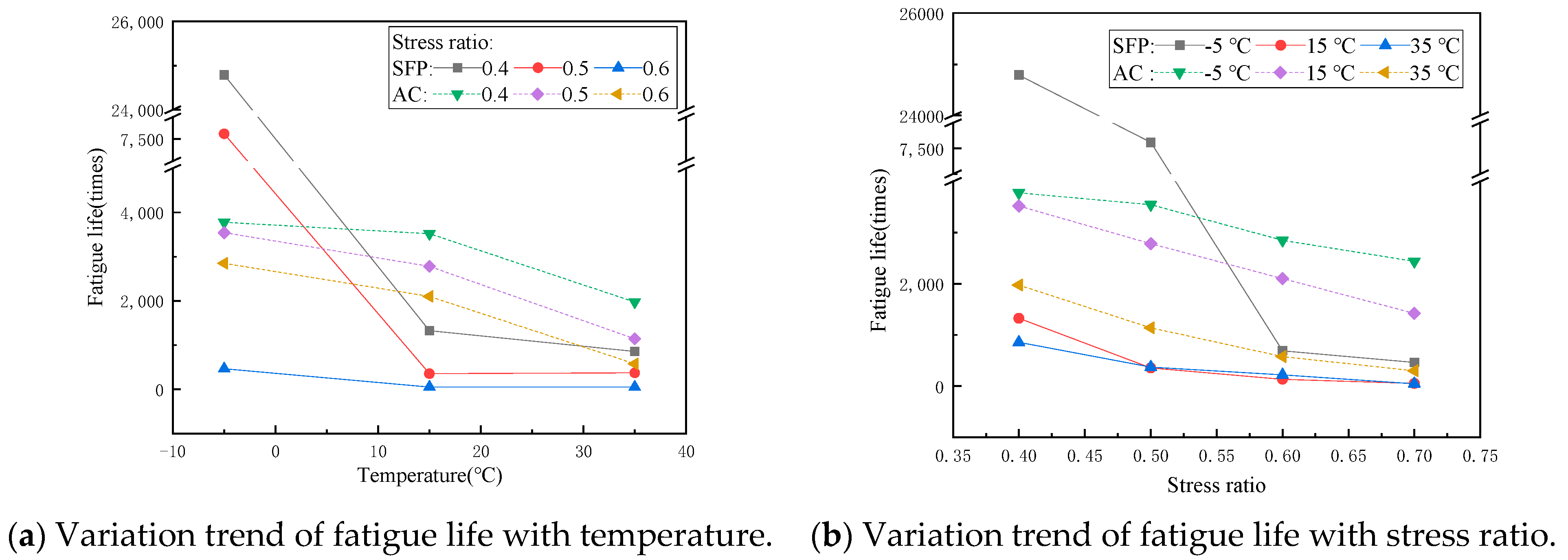Fatigue Resistance and Cracking Mechanism of Semi-Flexible Pavement Mixture
Abstract
:1. Introduction
- Evaluate the fatigue resistance of the SFP mixtures under different conditions by SCB fatigue test. Establish fatigue prediction model of the SFP mixtures.
- Analyze the composition of fracture surface in SCB fatigue test by digital image processing technology to investigate its cracking mechanism. Discuss the influence of the difference between asphalt binder and grouting material on the fatigue cracking mechanism under different conditions.
2. Materials and Methods
2.1. Materials
2.2. Experiment
2.3. Analysis Methodology
2.3.1. Fatigue Prediction Model of Materials in Laboratory
2.3.2. Analysis Method of Fracture Surface in SCB Fatigue Test
3. Results and Discussion
3.1. SCB Fatigue Test Results
3.2. Discussion on Fatigue Performance of the SFP Mixture
3.3. Digital Image Processing Results
3.4. Discussion on Cracking Mechanism of the SFP Mixture
4. Conclusions
- At a low temperature and low stress ratio, the fatigue resistance of the SFP is 2–7 times that of AC. At a medium temperature or high stress, the fatigue resistance of the SFP suddenly drops to 15–45% of AC. Under the condition of high temperature and a high stress ratio, SFP almost loses its anti-fatigue ability.
- The main reason for the poor fatigue resistance of the SFP mixture is the poor deformation capacity and low strength of grouting materials.
- The performance difference between grouting material and asphalt binder is large, which leads to the difference of fatigue cracking mechanism of the SFP mixture under different conditions.
- Under a fatigue load, the weak position of the SFP mixture at la ow temperature is asphalt binder and its interface with other materials, while at medium and high temperatures, the weak position of the SFP mixture is inside the grouting material.
- The research on improving the fatigue resistance of the SFP mixture at medium and high temperatures can start from improving the deformation resistance and strength of grouting material.
Author Contributions
Funding
Institutional Review Board Statement
Informed Consent Statement
Data Availability Statement
Acknowledgments
Conflicts of Interest
References
- Bai, Y.; He, J.; He, C. Study on field test application and detection evaluation of semi flexible pavement materials. Shanghai Highw. 2020, 1, 18–23. [Google Scholar]
- Tan, J.; Deng, S.; Gong, M.; Ding, Q.; Xiong, Z.; Wu, W. Application of Semi-Flexible Pavement in Rutting Treatment of Municipal Roads. China Munic. Eng. 2021, 3, 102–129. [Google Scholar]
- Qiu, Y.; Cai, X.; Xiao, H. Research on Self-healing Durability of Semi-flexible Pavement Materials Grouted with ECC Mortar. Highway 2020, 10, 1–5. [Google Scholar]
- Guo, X.; Hao, P. Influential Factors and Evaluation Methods of the Performance of Grouted Semi-Flexible Pavement (GSP)—A Review. Appl. Sci. 2021, 11, 6700. [Google Scholar] [CrossRef]
- Hanpu, D. Experimental study on fatigue resistance of semi-flexible pavement materials. East China Highw. 2020, 3, 112–114. [Google Scholar]
- Cai, X.; Zhang, H.; Zhang, J.; Chen, X.; Yang, J.; Hong, J. Investigation on reinforcing mechanisms of semi-flexible pavement material through micromechanical model. Constr. Build. Mater. 2019, 198, 732–741. [Google Scholar] [CrossRef]
- Cai, J.; Pei, J.; Luo, Q.; Zhang, J.; Li, R.; Chen, X. Comprehensive service properties evaluation of composite grouting materials with high-performance cement paste for semi-flexible pavement. Constr. Build. Mater. 2017, 153, 544–556. [Google Scholar] [CrossRef]
- Guangying, L. The Application of Phase Change Material in The Semi-flexible Pavement. Master’s Thesis, Chang’an University, Xi’an, China, 2013. [Google Scholar]
- Shooshtarian, S.; Rajagopalan, P. Daytime thermal performance of different urban surfaces: A case study in educational institution precinct of Melbourne. Archit. Sci. Rev. 2018, 61, 29–47. [Google Scholar] [CrossRef]
- Jiahong, W. Research on Crack Resistance of Semi-flexible Pavement Materials. E3S Web Conf. 2021, 248, 01020. [Google Scholar] [CrossRef]
- Kaixuan, Z. Study on Micromechanical Properties and Layer Optimization of Semi-Flexible Pavement Material. Master’s Thesis, Southeast University, Nanjing, China, 2018. [Google Scholar]
- Ding, Q.; Zhao, M.; Shen, F.; Zhang, X. Mechanical Behavior and Failure Mechanism of Recycled Semi-flexible Pavement Material. J. Wuhan Univ. Technol.-Mater. Sci. Ed. 2015, 30, 981–988. [Google Scholar] [CrossRef]
- Setyawan, A. Asessing the Compressive Strength Properties of Semi-Flexible Pavements. Procedia Eng. 2013, 54, 863–874. [Google Scholar] [CrossRef] [Green Version]
- Cai, X.; Fu, L.; Zhang, J.; Chen, X.; Yang, J. Damage analysis of semi-flexible pavement material under axial compression test based on acoustic emission technique. Constr. Build. Mater. 2020, 239, 117773. [Google Scholar] [CrossRef]
- Hao, C. Research on Optimization of Semi-Flexible Pavement Structure Based on Crack Resistance. Master’s Thesis, Southeast University, Nanjing, China, 2019. [Google Scholar]
- Cai, X.; Shi, C.; Chen, X.; Yang, J. Identification of damage mechanisms during splitting test on SFP at different temperatures based on acoustic emission. Constr. Build. Mater. 2021, 270, 121391. [Google Scholar] [CrossRef]
- Wang, L.M.; Juan, H.W. Study on Influencing Factors of Low Temperature Crack Resistance of Semi-flexible Pavement Materials Based on Freezing Test. J. Highw. Transp. Res. Dev. 2020, 37, 39–44. [Google Scholar]
- Afonso, M.L.; Dinis-Almeida, M.; Pereira-de-Oliveira, L.A.; Castro-Gomes, J.; Zoorob, S.E. Development of a semi-flexible heavy duty pavement surfacing incorporating recycled and waste aggregates—Preliminary study. Constr. Build. Mater. 2016, 102, 155–161. [Google Scholar] [CrossRef]
- Wang, D.; Liang, X.; Li, D.; Liang, H.; Yu, H. Study on Mechanics-Based Cracking Resistance of Semiflexible Pavement Materials. Adv. Mater. Sci. Eng. 2018, 2018, 8252347. [Google Scholar] [CrossRef] [Green Version]
- An, S.; Ai, C.; Ren, D.; Rahman, A.; Qiu, Y. Laboratory and Field Evaluation of a Novel Cement Grout Asphalt Composite. J. Mater. Civ. Eng. 2018, 30, 04018179. [Google Scholar] [CrossRef]
- Cihackova, P.; Hyzl, P.; Stehlik, D.; Dasek, O.; Sernas, O.; Vaitkus, A. Performance Characteristics of the Open-Graded Asphalt Concrete Filled With a Special Cement Grout. Balt. J. Road Bridge Eng. 2015, 10, 316–324. [Google Scholar] [CrossRef]
- Dong, Q.W.; Zhang, Y. The semi-rigid pavement with higher performances for roads and parking aprons. In CAFEO 29, Sustainable Urbanization—Engineering Challenges and Opportunities; Chemilink Technologies Group: Singapore, 2011; pp. 1–7. [Google Scholar]
- Hassani, A.; Taghipoor, M.; Karimi, M.M. A state of the art of semi-flexible pavements: Introduction, design, and performance. Constr. Build. Mater. 2020, 253, 119196. [Google Scholar] [CrossRef]
- Shafabakhsh, G.; Mirabdolazimi, S.M.; Sadeghnejad, M. Evaluation the effect of nano-TiO2 on the rutting and fatigue behavior of asphalt mixtures. Constr. Build. Mater. 2014, 54, 566–571. [Google Scholar] [CrossRef]
- Lv, S.; Wang, X.; Liu, C.; Wang, S. Fatigue Damage Characteristics Considering the Difference of Tensile-Compression Modulus for Asphalt Mixture. J. Test. Eval. 2018, 46, 2470–2482. [Google Scholar] [CrossRef]
- Lu, S.T.; Liu, C.C.; Qu, F.T.; Zheng, J.L. Test Methods and Characterization on Fatigue Performance of Asphalt Mixtures: A Review. China J. Highw. Transp. 2020, 33, 67–75. [Google Scholar]
- Huang, B.; Shu, X.; Zuo, G. Using notched semi circular bending fatigue test to characterize fracture resistance of asphalt mixtures. Eng. Fract. Mech. 2013, 109, 78–88. [Google Scholar] [CrossRef]
- Dong, Q.; Zhao, X.; Chen, X.; Ma, X.; Cui, X. Long-term mechanical properties of in situ semi-rigid base materials. Road Mater. Pavement Des. 2021, 22, 1692–1707. [Google Scholar] [CrossRef]
- Gong, M.; Xiong, Z.; Chen, H.; Deng, C.; Chen, X.; Yang, J.; Zhu, H.; Hong, J. Evaluation on the cracking resistance of semi-flexible pavement mixture by laboratory research and field validation. Construct. Build. Mater. 2019, 207, 387–395. [Google Scholar] [CrossRef]
- Krans, R.L.; Tolman, F.; Van, D. Semi-circular bending test: A practical crack growth test using asphalt concrete cores. In Proceedings of the International Rilem Conference on Reflective Cracking in Pavements, Maastricht, The Netherlands, 2–4 October 1996. [Google Scholar]
- Mull, M.A.; Othman, A.; Mohammad, L. Fatigue Crack Propagation Analysis of Chemically Modified Crumb Rubber-Asphalt Mixtures. J. Elastomers Plast. 2005, 37, 37–73. [Google Scholar] [CrossRef]
- Jiang, J.; Ni, F.; Dong, Q.; Wu, F.; Dai, Y. Research on the fatigue equation of asphalt mixtures based on actual stress ratio using semi-circular bending test. Constr. Build. Mater. 2018, 158, 996–1002. [Google Scholar] [CrossRef]
- Gilat, A. MATLAB. (Electronic Resource): An Introduction with Applications, 5th ed.; John Wiley & Sons: Hoboken, NJ, USA, 2015. [Google Scholar]







| Properties | Unit | Test Value | Requirements (GB T 494–2010) |
|---|---|---|---|
| Softening point | °C | 75 | ≥60 |
| Ductility (5 °C) | cm | 30 | ≥20 |
| Penetration (100 g, 25 °C) | 0.1 mm | 54 | 40–60 |
| Storage stability | °C | 1.2 | ≤2.5 |
| Viscosity | Pa·s | 2.0 | ≤3.0 |
| Flash point | °C | 311 | ≥230 |
| Elasticity recovery (25 °C) | % | 92 | ≥75 |
| Mixture Component | Content |
|---|---|
| Aggregate (mm) | 98.0 |
| Limestone powder | 2.0 |
| SBS Modified asphalt | 4.2 |
| MA100 | 0.3 |
| Lignin fiber | 0.2 |
| Fluidity/s | Setting Time/h | Compressive Strength/MPa | 24 h Bleeding Rate (%) | Dry Shrinkage Ratio (%) | |||||
|---|---|---|---|---|---|---|---|---|---|
| Initial | 30 min | Initial | Final | 2 h | 3 h | 3 d | 28 d | ||
| 10.3 | 12.6 | 0.9 | 1.4 | 15.8 | 24.0 | 34.5 | 42.3 | 0.1 | 0.14 |
| Factor | Content |
|---|---|
| Material | SFP-13 |
| Stress ratio | 0.4, 0.5, 0.6, 0.7 |
| Temperature (°C) | −5, 15, 35 |
| Load frequency (Hz) | 10 |
| Times of parallel tests | 3 |
| R2 | |||||
|---|---|---|---|---|---|
| 81.746 | 0.222 | 0.0638 | −3.371 | 36.986 | 0.9937 |
Publisher’s Note: MDPI stays neutral with regard to jurisdictional claims in published maps and institutional affiliations. |
© 2021 by the authors. Licensee MDPI, Basel, Switzerland. This article is an open access article distributed under the terms and conditions of the Creative Commons Attribution (CC BY) license (https://creativecommons.org/licenses/by/4.0/).
Share and Cite
Wang, S.; Zhou, H.; Chen, X.; Gong, M.; Hong, J.; Shi, X. Fatigue Resistance and Cracking Mechanism of Semi-Flexible Pavement Mixture. Materials 2021, 14, 5277. https://doi.org/10.3390/ma14185277
Wang S, Zhou H, Chen X, Gong M, Hong J, Shi X. Fatigue Resistance and Cracking Mechanism of Semi-Flexible Pavement Mixture. Materials. 2021; 14(18):5277. https://doi.org/10.3390/ma14185277
Chicago/Turabian StyleWang, Shiqi, Huanyun Zhou, Xianhua Chen, Minghui Gong, Jinxiang Hong, and Xincheng Shi. 2021. "Fatigue Resistance and Cracking Mechanism of Semi-Flexible Pavement Mixture" Materials 14, no. 18: 5277. https://doi.org/10.3390/ma14185277
APA StyleWang, S., Zhou, H., Chen, X., Gong, M., Hong, J., & Shi, X. (2021). Fatigue Resistance and Cracking Mechanism of Semi-Flexible Pavement Mixture. Materials, 14(18), 5277. https://doi.org/10.3390/ma14185277







